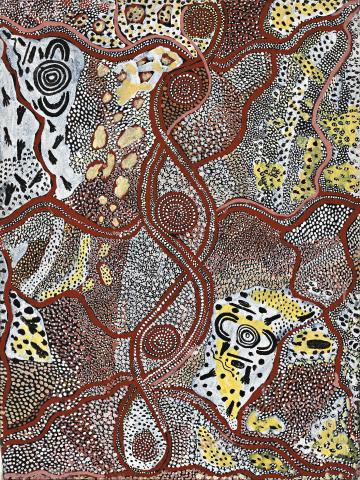WOMEN CAMPED AT KAMPURRULA, 1973
JOHNNY WARANGKULA TJUPURRULA
synthetic polymer paint on board
58.0 x 43.0 cm
bears inscription verso: JW 730807
Papunya Tula Artists, Northern Territory
Arunta Gallery, Northern Territory
Private collection, Netherlands
Private collection, London
The Collectors’ Exhibition, Lauraine Diggins Fine Art, Melbourne, 6 August – 29 October 2016 (label attached verso)
Women’s Dreamings are relatively rare in the corpus of paintings by Johnny Warangkula Tjupurrula. This particularly fine example, painted towards the end of the first, golden era of the Papunya acrylic painting movement in August 1973, features two women’s camps in luxuriant fields of bush tucker nourished by the rains created by the ancestor beings. The artist is renowned for his early paintings of Rain and Water Dreamings set in his traditional lands around the sites of Kalipinypa, Tjikari and Ilpilli. These paintings shimmer with patchworks of overlapping dots and stippling to suggest the ancestral forces that created the landscape and the richness of edible resources that abound across the country.
Kampurarrpa (Kampurrula) is a site close to Ilpilli in the Ehrenberg Ranges where Warangkula established a camp in the early days of the outstation movement following the enactment of the Northern Territory Land Rights legislation in 1976. The painting shows two camps; the women, symbolised by the double-U forms either side of a set of concentric circles, are identified by their equipment–digging sticks and oval carrying dishes. Their footprints, leaving and returning to the camps suggest a series of foraging and collecting expeditions; they also mark the choreography of ceremony. The set of roundels that run vertically through the composition are likely to represent waterholes, and the continuous lines that weave around these relate to one of the graphic symbols for rain that permeate Warangkula’s paintings: see for example, Water and bush tucker Dreaming, 1972, and Water and bush tucker story, 1972.1 The red lines that meander laterally and diagonally across the picture plane may suggest a form of vine (ngalyipi) woven by ancestral women into ceremonial paraphernalia.
Women Camped at Kampurrula relates to one of the first monumental canvases to be painted at Papunya, a year later in 1974– Warangkula’s Kampurarrpa in the collection of the National Gallery of Victoria2 which also features two women’s camps.
1. see Ryan, J. and P. Batty, Tjukurrtjanu: Origins of Western Desert art, National Gallery of Victoria, Melbourne, 2011, pp. 270 and 271 respectively (illus.)
2. ibid., pp. 278 – 9
WALLY CARUANA
